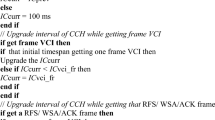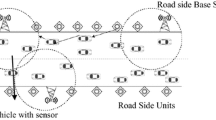Abstract
Nodes in vehicular ad-hoc network (VANET) are highly mobile, traversing in unpredictable and varying environment. Therefore, contention window size and transmission power should adapt according to the high mobility transmission environment. In this paper, we propose an adaptive VANET medium access control (MAC) layer with joint optimization for VANET (MACVS) which aims at minimizing average delay and maximizing packet success rate. An adaptive joint optimization with proposed threshold structure dynamic programming, with closed loop feedback control system, is designed to optimize contention window size and transmission power. Adaptive optimization is done based on road traffic conditions and transmission reliable distance range (depicted by interference and noise), by monitoring the continuous change and threshold of received signal strength to interference and noise ratio. Mathematical expressions have been developed for the MACVS optimization framework, and the produced analytical results show good agreement with the simulation results. Simulations with different arrival rates and urban map of city center show that the proposed MACVS with low complexity joint optimization effectively reduces end-to-end delay while achieving high packet success rate under various network traffic condition.
























Similar content being viewed by others
Abbreviations
- VANET:
-
Vehicular adhoc network
- MAC:
-
Medium access control
- SINR:
-
Signal to noise and interference ratio
- DP:
-
Dynamic programming
- TRDR:
-
Transmission reliable distance range
- MACVS:
-
Adaptive VANET MAC with joint optimization
- EDCA:
-
Enhanced distributed channel access
- MarPVS:
-
Markov distance prediction with new priority VANET scheme
- QoS:
-
Quality of service
- CW:
-
Contention window size
References
Karedal, J., Czink, N., Paier, A., Tufvesson, F., & Molisch, A. F. (2011). Path loss modeling for vehicle-to-vehicle communications. IEEE Transactions on Vehicular Technology, 60(1), 323–328.
Park, Y., & Kim, H. (2013). Collision control of periodic safety messages with strict messaging frequency requirements. IEEE Transactions on Vehicular Technology, 62(2), 843–852.
Deng, D.-J., Chen, H.-C., Chao, H.-C., & Huang, Y.-M. (2011). A collision alleviation scheme for IEEE 802.11p VANETs. Wireless Personal Communication, 372–383.
Rawat, D. B., Popescu, D. C., Yan, G., & Olariu, S. (2011). Enhancing VANET performance by joint adaptation of transmission power and contention window size. IEEE Transactions on Parallel and Distributed Systems, 22(9), 1–8.
Liu, J., Wan, J., Wang, Q., Deng, P., Zhou, K., & Qiao, Y. (2015). A survey on position-based routing for vehicular ad hoc networks. Telecommunication Systems. doi:10.1007/s11235-015-9979-7.
Li, P., Guo, S., Yu, S., & Vasilakos, A. V. (2012). CodePipe: An opportunistic feeding and routing protocol for reliable multicast with pipelined network coding. INFOCOM, 2012, 100–108.
Yen, Y.-S., Chao, H.-C., Chang, R.-S., & Vasilakos, A. (2011). Flooding-limited and multi-constrained QoS multicast routing based on the genetic algorithm for MANETs. Mathematical and Computer Modelling, 53(11–12), 2238–2250.
Spyropoulos, T., Rais, R. N. B., Turletti, T., Obraczka, K., & Vasilakos, A. (2010). Routing for disruption tolerant networks: Taxonomy and design. Wireless Networks, 16(8), 2349–2370.
Youssef, M., Ibrahim, M., Abdelatif, M., Chen, L., & Vasilakos, A. V. (2014). Routing metrics of cognitive radio networks: A survey. IEEE Communications Surveys and Tutorials., 16(1), 92–109.
Xiao, Y., Peng, M., Gibson, J., Xie, G. G., Du, D.-Z., & Vasilakos, A. V. (2012). Tight performance bounds of multihop fair access for mac protocols in wireless sensor networks and underwater sensor networks. IEEE Transaction on Mobile Computing, 11(10), 1538–1554.
Vasilakos, A., Ricudis, C., Anagnostakis, K., & Pedryca, W. (1998). Evolutionary-fuzzy prediction for strategic QoS routing in broadband networks. The 1998 IEEE international conference on fuzzy systems proceedings, vol. 2, pp. 1488–1493.
Li, P., Guo, S., Yu, S., & Vasilakos, A. V. (2014). Reliable multicast with pipelined network coding using opportunistic feeding and routing. IEEE Transactions on Parallel and Distributed Systems, 25(12), 3264–3273.
Meng, T., Wu, F., Yang, Z., Chen, G., & Vasilakos, A. (2015). Spatial reusability-aware routing in multi-hop wireless networks. IEEE Transactions on Computers, 99(1), 1.
Booysen, M. J., Zeadally, S., & Van Rooyen, G.-J. (2011). Survey of media access control protocols for vehicular ad hoc networks. IET Communication, 5(11), 1619–1631.
Gozalvez, J., Sepulcre, M., & Bauza, R. (2011). Impact of the radio channel modelling on the performance of VANET communication protocols. Telecommunication System, 50, 149–167.
Minghui, Z., & Huiqing, Z. (2010). Research on model of indoor distance measurement based on receiving signal strength. 2010 International conference on computer design and applications, vol. 5, pp. 54–58.
Duarte, P. B. F., Fadlullah, Z. M., Vasilakos, A. V., & Kato, N. (2012). On the partially overlapped channel assignment on wireless mesh network backbone: A game theoretic approach. IEEE Journal on Selected Areas in Communications, 30(1), 119–127.
Liu, J., Wan, J., Wang, Q., Li, D., Qiao, Y., & Cai, H. (2015). A novel energy-saving one-sided synchronous two-way ranging algorithm for vehicular positioning. Mobile Networks and Applications. doi:10.1007/s11036-015-0604-5.
Vasilakos, A. V., Zhang, Y., & Spyropoulos, T. (2012). Delay tolerant networks: Protocols and applications. Boca Raton: CRC Press.
Li, M., Li, Z., & Vasilakos, A. V. (2013). A survey on topology control in wireless sensor networks: Taxonomy, comparative study, and open issues. Proceedings of the IEEE, 101(12), 2538–2557.
Yao, Y., Cao, Q., & Vasilakos, A. V. (2013). EDAL: An energy-efficient, delay-aware, and lifetime-balancing data collection protocol for wireless sensor networks. MASS, 2013, 182–190.
Xiang, L., Luo, J., & Vasilakos, A. V. (2011). Compressed data aggregation for energy efficient wireless sensor networks. SECON, 2011, 46–54.
Campolo, C., Molinaro, A., Vinel, A., & Zhang, Y. (2012). Modeling prioritized broadcasting in multichannel vehicular networks. IEEE Transaction on Vehicular Technology, 61(2), 687–701.
Wang, X., Vasilakos, A. V., Chen, M., Liu, Y., & Kwon, T. T. (2012). A survey of green mobile networks: Opportunities and challenges. MONET., 17(1), 4–20.
Chenga, H., Xiong, N., Vasilakos, A. V., Yang, L. T., Chen, G., & Zhuang, X. (2012). Nodes organization for channel assignment with topology preservation in multi-radio wireless mesh networks. Ad Hoc Networks, 10(5), 760–773.
Attar, A., Tang, H., Vasilakos, A. V., Yu, F. R., & Leung, V. C. M. (2012). A survey of security challenges in cognitive radio networks: Solutions and future research directions. Proceedings of the IEEE, 100(12), 3172–3186.
Zhang, X. M., Zhang, Y., Yan, F., & Vasilakos, A. V. (2015). Interference-based topology control algorithm for delay-constrained mobile ad hoc networks. IEEE Transactions on Mobile Computing, 14(4), 742–754.
He, Y., Sun, J., Ma, X., Vasilakos, A. V., Yuan, R., & Gong, W. (2013). Semi-random backoff towards resource reservation for channel access in wireless LANs. IEEE/ACM Transaction on Network, 21(1), 204–217.
Kassotakis, I. E., Markaki, M. E., & Vasilakos, A. V. (2000). A hybrid genetic approach for channel reuse in multiple access telecommunication networks. IEEE Journal on Selected Areas in Communications, 18(2), 234–243.
Cheng, X., Wang, C.-X., Laurenson, D. I., Salous, S., & Vasilakos, A. V. (2009). An adaptive geometry-based stochastic model for non-isotropic MIMO mobile-to-mobile channels. IEEE Transactions on Wireless Communications, 8(9), 4824–4835.
Zhou, L., Chao, H.-C., & Vasilakos, A. V. (2011). Joint forensics-scheduling strategy for delay-sensitive multimedia applications over heterogeneous networks. IEEE Journal on Selected Areas in Communications, 29(7), 1358–1367.
Zhou, L., Xiong, N., Shu, L., Vasilakos, A. V., & Yeo, S.-S. (2014). Context-aware vehicular cyber-physical systems with cloud support: Architecture, challenges and solutions. IEEE Communications Magazine, 52(8), 106–113.
Vasilakos, A. V., Papadimitriou, G. I., & Paximadis, C. T. (1995). A new approach to the design of reinforcement schemes for learning automata: Stochastic estimator learning algorithm. Neurocomputing, 7(3), 275–297.
Zhang, Z., Wang, H., Vasilakos, A. V., & Fang, H. (2012). ECG-cryptography and authentication in body area networks. IEEE Transactions on Information Technology in Biomedicine, 16(6), 1070–1078.
Vinel, A., Campolo, C., Petit, J., & Koucheryavy, Y. (2011). Trustworthy broadcasting in IEEE 802.11p/WAVE vehicular networks: Delay analysis. IEEE Communications Letters, 15(9), 1010–1012.
Almalag, M. C., Weigle, M. S., & Olariu, S. (2013). MAC protocols for VANET. In S. Basagni, M. Conti, S. Giordano, & I. Stojrnenovic (Eds.), Mobile ad hoc networking: Cutting edge directions (2nd ed.). The Institute of Electrical and Electronics Engineers.
Lim, J. M.-Y., Chang, Y. C., Alias, M. Y., & Loo, J. (2015). Performance modelling of adaptive VANET scheme with priority based on distance and data type, KSII. Transaction on Internet and Information Systems, 9(4), 1337–1358.
Lim, J. M.-Y., Chang, Y. C., Alias, M. Y., & Loo, J. (2014). Cognitive VANET with enhanced priority scheme. International conference on telecommunications and multimedia (TEMU2014), June 2014.
Marler, R. T., & Arora, J. S. (2004). Survey of multi-objective optimization methods for engineering. Structural and Multidisciplinary Optimization, 26(6), 369–395.
Tomas-Gabarr, J.-B., Egea-Lopez, E., & Garcia-Haro, J. (2013). Vehicular trajectory optimization for cooperative collision avoidance at high speeds. IEEE Transactions on Intelligent Transportation Systems, 14(4), 1930–1941.
Khabazian, M., Aissa, S., & Mehmet-Ali, M. (2011). Performance modelling of message dissemination in vehicular ad hoc networks with priority. IEEE Journal on Selected Areas in Communications, 29(1), 61–71.
Xu, J., Liu, W., Lang, F., Zhang, Y., & Wang, C. (2011). Distance measurement model based on RSSI in WSN. Wireless Sensor Network, 2, 606–611.
Zeng, Y., Xiang, K., Li, D., & Vasilakos, A. V. (2013). Directional routing and scheduling for green vehicular delay tolerant networks. Wireless Networks, 19(2), 161–173.
Han, K., Luo, J., Liu, Y., & Vasilakos, A. V. (2013). Algorithm design for data communications in duty-cycled wireless sensor networks: A survey. IEEE Communications Magazine, 51(7), 107–113.
Busch, C., Kannan, R., & Vasilakos, A. V. (2012). Approximating congestion + dilation in networks via “quality of routing” games. IEEE Transaction Computers, 61(9), 1270–1283.
Sommer, C., German, R., & Dressler, F. (2011). Bidirectionally coupled network and road traffic simulation for improved IVC analysis. IEEE Transactions on Mobile Computing, 10(1), 3–15.
Acknowledgments
This research was funded in part by Motorola Mobility.
Author information
Authors and Affiliations
Corresponding author
Rights and permissions
About this article
Cite this article
Lim, J.MY., Chang, Y.C., Alias, M.Y. et al. Joint optimization and threshold structure dynamic programming with enhanced priority scheme for adaptive VANET MAC. Wireless Netw 22, 897–913 (2016). https://doi.org/10.1007/s11276-015-1009-x
Published:
Issue Date:
DOI: https://doi.org/10.1007/s11276-015-1009-x




